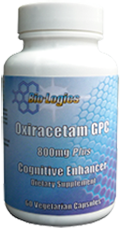Description
What is Oxiracetam GPC?
Oxiracetam [2-(4-hydroxy-2-oxopyrrolidin-1-yl)acetamide] is a fast acting water soluble analog of and the closet in structure to Piracetam, a cyclic derivative of GABA (the neurotransmitter Gamma Amino Butyric Acid). Oxiracetam is thought to be 3 to 6 times more potent than Piracetam, producing greater cognitive enhancing effects. It is chemically related to the amino acid Pyroglutamic Acid (Pyrrolidine Carboxylic Acid), which occurs in cerebrospinal fluid and plays an important role in cognitive functioning.
Researchers say that Oxiracetam is a “vigilance-enhancing compound with some effects on spontaneous memory” and that “in comparison with Piracetam, Oxiracetam exhibits a greater improvement in memory factor”. During another study, they found that Oxiracetam had better therapeutic results than Piracetam on both a psychosomatic and neurologic symptoms. Oxiracetam also seemed to decrease platelet aggregation.
Just like Piracetam, research has shown Oxiracetam to be very safe and non-toxic. It has been used safely in pregnant mice, whose offspring later were “more curious” and performed “significantly better on memory tests” than those who had not received Oxiracetam during fetal development. Although at this time we do not recommend that Oxiracetam be taken during pregnancy, as more research is required, it does show that Oxiracetam is a remarkable substance that we are highly likely to develop more uses for in the future.
Oxiracetam has shown to nutritionally support the treatment of alcoholism, stroke, Down syndrome, dementia vertigo, Alzheimer’s, dementia, sickle cell anemia, dyslexia, autism and numerous other health problems
Discounts are available for package purchases.
Think clearer, remember more and feel better.
Suggested Serving: Two (2) to four (4) capsules daily as a dietary supplement. Best when taken in intervals throughout the day. Greatest effect is seen generally after 3 weeks of daily use. Some literature recommends a high “attack” dose be taken for the first two days. When people first take Oxiracetam they may not notice any effect until they take a higher dose after, a user may notice that a lower amount is sufficient. Oxiracetam takes effect within 30 to 60 minutes. Greatest effect is seen generally after 3 weeks of daily use.
Notice:
Individual results may vary. You should always consult with your physician before starting this product or any health-related program. Galantamine is currently not recommended for use by young individuals.
Precautions:
When taken with other brain enhancement products the individual doses may have to be reduced in order to avoid possible, although rare, mild side effects such as headaches and nausea. If taken too late in the day, may cause sleep disturbance. Do not use if tamper resistant seal is missing or broken. Consult your physician prior to use if you are pregnant or nursing.
KEEP OUT OF REACH OF CHILDREN
Our Supplements contain only the purest natural ingredients according to the highest standards. We use only the most natural fillers when needed. There is a difference and we have it! Read More.

DISCLAIMER
THESE STATEMENTS HAVE NOT BEEN EVALUATED BY THE FOOD AND DRUG ADMINISTRATION. THESE PRODUCTS ARE NOT INTENDED TO DIAGNOSE, TREAT, CURE OR PREVENT ANY DISEASE. ALL INFORMATION FOR ALL PRODUCTS IS EDUCATIONAL ONLY AND IS TAKEN FROM VARIOUS THIRD PARTY SOURCES, AVAILABLE ON REQUEST. IT DOES NOT AND SHOULD NOT REPLACE THE ADVICE OF YOUR PHYSICIAN. THESE PRODUCTS ARE OFFERED AS DIETARY SUPPLEMENTS ONLY. WE DO NOT ENDORSE OR ADOPT THE INFORMATION AND CLAIMS CONTAINED IN THE THIRD PARTY SOURCES.
Links:
References:
Ammassari-Teule, M., D’Amato, F.R., Sansone, M., Oliverio, A. “Avoidance Facilitation in Adult Mice by Prenatal Administration of the Nootropic Drug Oxiracetam.” Pharmacological Research Communications. 1986, Vol. 18, No. 12, pp. 1169‑78.
Ammassari-Teule, M., D’Amato, F.R., Sansone, M., Oliverio, A. “Enhancement of Radial Maze Performances in CD1 Mice after Prenatal Exposure to Oxiracetam: Possible Role of Sustained Investigative Responses Developed During Ontogeny.” Physiology and Behavior. 1988, 42 (3), pp. 281‑5.
Barclays de Zoete Wedd Chemicals Research. Switzerland Issue 1, June 25, 1987, pp. 4‑5.
Ibid. Issue 88, July 11, 1988, pp. 5‑6.
Ferrero, E. “Controlled Clinical Trial of Oxiracetam in the Treatment of Chronic Cerebrovascular Insufficiency in the Elderly.” Current Therapeutic Research. August 1984, Vol. 36, No. 2, pp. 298‑308.
Itil, T.M., Menon, G.N., Songar, A., Itil, K.Z. “CNS Pharmacology and Clinical Therapeutic Effects of Oxiracetam.” Clinical Neuropharmacology. 1986, Vol. 9, Supplement 3. New York: Raven Press, pp. S70‑S78.
Japan Chemical Week. Vol 28, Issue 1445, December 12, 1987, p. 4.
Kuribara, H., Tadokoro, S. “Facilitating Effect of Oxiracetam and Piracetam on Acquisition of Discrete Two-Way Shuttle Avoidance in Normal Mice.” Japanese Journal of Pharmacology. 1988, 48 (4), pp. 494‑8.
Maina, G., Fiori, L., Torta, R., Fagiani, M.B., Ravizza, L., Bonavita, E., Ghiazza, B., Teruzzi, F., Zagnoni, P.G., Ferrario, E., et al. “Oxiracetam in the Treatment of Primary Degenerative and Multi-Infarct Dementia: a Double-Blind, Placebo-Controlled Study.” Neuropsychobiology. 1989, 21 (3), pp. 141‑5.
Mondadori, C., Classen, W., Borkowski, J., Ducret, T., Buerki, H., Schade, A. “Effects of Oxiracetam on Learning and Memory in Animals: Comparison with Piracetam.” Clinical Neuropharmacology. 1986, Vol. 9, Supplement 13. New York: Raven Press, pp. S27‑S37.







Reviews
There are no reviews yet.